
Ilya Yefimovich Repin was a Ukrainian-born Russian painter. He became one of the most renowned artists in Russia in the 19th century. His major works include Barge Haulers on the Volga (1873), Religious Procession in Kursk Province (1880–1883), Ivan the Terrible and His Son Ivan (1885); and Reply of the Zaporozhian Cossacks (1880–1891). He is also known for the revealing portraits he made of the leading Russian literary and artistic figures of his time, including Mikhail Glinka, Modest Mussorgsky, Pavel Tretyakov, and especially Leo Tolstoy, with whom he had a long friendship.

Pavel Mikhaylovich Tretyakov was a Russian businessman, patron of art, collector, and philanthropist who gave his name to the Tretyakov Gallery and Tretyakov Drive in Moscow. His brother Sergei Tretyakov was also a famous patron of art and a philanthropist.

Peredvizhniki, often called The Wanderers or The Itinerants in English, were a group of Russian realist artists who formed an artists' cooperative in protest of academic restrictions; it evolved into the Society for Travelling Art Exhibitions in 1870.

Ivan Nikolayevich Kramskoi was a Russian Realist painter and art critic. He was an intellectual leader of the art movement known as the Wanderers between 1860 and 1880.

Valentin Alexandrovich Serov was a Russian painter and one of the premier portrait artists of his era.

Karl Pavlovich Bryullov, also Briullov or Briuloff, born Charles Bruleau was a Russian painter. He is regarded as a key figure in transition from the Russian neoclassicism to romanticism.

The State Tretyakov Gallery is an art gallery in Moscow, Russia, which is considered the foremost depository of Russian fine art in the world.

Viktor Mikhaylovich Vasnetsov was a Russian artist who specialised in mythological and historical subjects. He is considered a co-founder of Russian folklorist and romantic nationalistic painting, and a key figure in the Russian Revivalist movement.

Nikolai Nikolaevich Ge was a Russian painter who was influential in the development of Russian symbolism. He was famous for his works on historical and religious subjects.

Christ in the Desert or Christ in the Wilderness is an 1872 painting by Russian artist Ivan Kramskoi, reflecting the temptation of Christ. Kramskoi was offered a professorship for the painting by the Russian Academy of Arts Council but rejected it in the beginning of 1873. He had been expelled from the Academy earlier, and chose to keep his "youthful commitment to independence from the Academy". Subsequently, it became one of the favourite paintings of Pavel Tretyakov, who bought it for his gallery in the year the painting was finished.
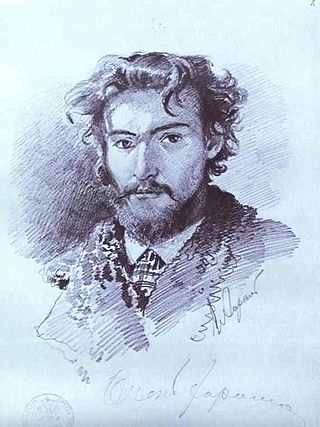
Fyodor Alexandrovich Vasilyev was a Russian Imperial landscape painter who introduced the lyrical landscape style in Russian art.
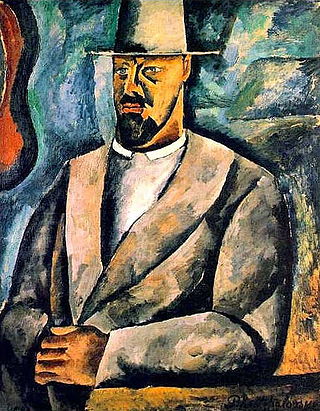
Pyotr Petrovich Konchalovsky was a Russian and Soviet painter, a member of the Knave of Diamonds group.
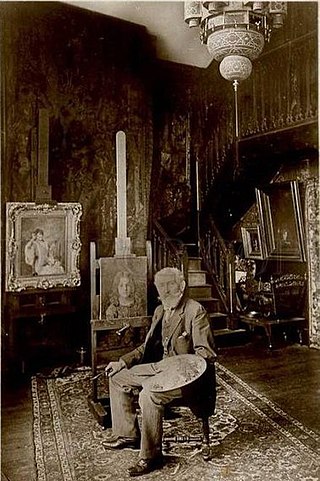
Alexei Alexeievich Harlamov (1840–1925) was a Russian painter, who usually signed his name in the Latin alphabet as Harlamoff.

Nikolay Andreyevich Koshelev was a Russian painter, illustrator and muralist. He specialized in portraits and genre scenes, as well as icon painting.
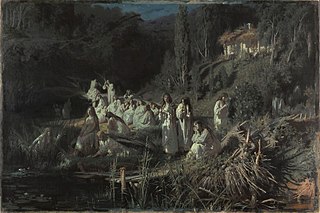
The Mermaids is an 1871 oil on canvas by the Russian artist Ivan Kramskoi.

Portrait of an Unknown Woman, also known as The Unknown Woman, An Unknown Lady or Stranger is an oil painting by the Russian artist Ivan Kramskoi, painted in 1883. The model, whose identity is unknown, is a woman of "quiet strength and forthright gaze". It is one of Russia's best-known artworks, although a number of critics were indignant when the painting was first exhibited and condemned what they saw as a depiction of a haughty and immoral woman. Its popularity has grown with changes in public taste.
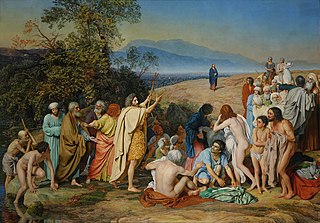
The Appearance of Christ Before the People or The Apparition of the Messiah is an oil painting on canvas, measuring 540 cm × 750 cm, by the Russian painter Alexander Andreyevich Ivanov (1806–1858).

At the Dressing-Table. Self-Portrait is a 1909 painting by Russian-French painter Zinaida Serebriakova. The painting is in the collection of the Tretyakov Gallery in Moscow. Its size is 75 × 65 cm.

Ivan the Terrible and His Son Ivan on 16 November 1581 is a painting by Russian realist artist Ilya Repin made between 1883 and 1885. It depicts the grief-stricken Russian tsar Ivan the Terrible cradling his dying son, the Tsarevich Ivan Ivanovich, shortly after Ivan the Terrible had dealt a fatal blow to his son's head in a fit of anger. The painting portrays the anguish and remorse on the face of the elder Ivan and the shock and heartbreak of the dying Tsarevich, shedding a tear at the unexpected betrayal and shock of having been killed by his father's hands.
Valery Alexandrovich Volkov was a Soviet-Russian painter and art historian who lived and worked in Central Asia and in Russia. Intercultural experiences and knowledge gleaned from the art history of two different cultures was reflected in a distinctive fusion of influences in his paintings. His painting style is associated with abstract expressionism and merges a sensual world of colour of the Orient and the gestural brush technique of European modernism.



















